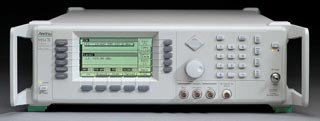
|
|
The Anritsu 69347A 20.0 GHz Ultra Low Noise Synthesized Sweep/Signal Generator features 10 MHz to 20 GHz analog, step, and manual sweep capability. Output levels to +17 dBm and optional 0.1 Hz resolution. It provides AM and FM via external modulating signals or internal arbitrary waveform generators. The internal generators offer 7 modulating waveforms, including Gaussian noise, as well as user-defined arbitrary waveforms. Pulse modulation parameters can be set externally or by the internal pulse generator. Doublet, triplet, or quadruplet pulses make RADAR blind spot testing easy. Simultaneous synchronized modulations let you set complex signal scenarios across the entire frequency range. Specifications. Frequency Range: 0.01 to 20 GHz. CW mode Output: Twenty independent, presettable CW frequencies (FO to F9 and MO to M9). CW mode Accuracy: Same as internal or external 10 MHz time base. CW mode Resolution: 1 kHz (0.1 Hz with Option 11). Phase-locked step sweep mode Sweep width: Independently selected, 1 kHz (0.1 Hz with Option 11) to full range, every frequency step in sweep range is phase-locked. Phase-locked step sweep mode Resolution (Min. step size): 1 kHz (0.1 Hz with Option 11). Spurious signals Harmonic and harmonic related: <-30 dBc (10 to 50 MHz), <-40 dBc ( >50 MHz to <= 2 GHz), <-60 dBc ( >2 GHz to <= 20 GHz). Output power: +13 dBm (>= 0.01 to 20 GHz). Options. Option 2B, Step attenuator. Option 6, Phase modulation capability (Not available with option 7). Option 7, Generators deletes the internal AM and FM generators (Not available in combination with Option 6, 8, 10 or 20). Option 8, Internal power meter (Not available with Option 7). Option 9, Rear panel RF output. Option 10, Complex modulation(Not available with option 7). Option 11, 0.1 Hz frequency resolution. Option 15, High power output. Option 16, High stability time base. Option 17, Delete front panel. Option 18, MM-wave bias. Option 19, SCPI programmability adds GPIB command mnemonics.
|